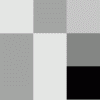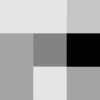Suppose you go around taking extremely close-up black-and-white pictures of randomly chosen natural and unnatural objects (rocks, trees, streams, buildings, etc.). What do they look like?
Well, each one looks like a patch of varying shades of gray, of course. But do some patches arise more than others? If each of your close-ups is, say, three pixels by three pixels, Which would you expect to see more of:
| This? |  |
Or this? |  |
Well, each 3 x 3 square of pixels is essentially a list of nine numbers (one for the darkness of each pixel, so that a pure black pixel is a “1”, a pure white pixel is a “0”, a nearly-black pixel is, say, a “.9”, etc.). A list of nine numbers specifies a location in nine-dimensional euclidean space (just as a list of three numbers specifies a location in the three-dimensional space in which we appear to live). So the question becomes: Where in nine-dimensional space do close-up patches of photos tend to live?
A natural expectation is that they’re scattered randomly — and at first blush that appears to be accurate. But it turns out that if you take a closer look, using a mathematical “lens” that lets you see more clearly into nine dimensions, they’re not scattered randomly at all. Instead, they’re clustered around (of all things!) a Klein bottle, which is a two-dimensional surface that can’t be squeezed into three dimensions, but fits perfectly well in nine (or for that matter in four).
(Actually it’s a somewhat thickened Klein bottle, and hence four-dimensional instead of two-dimensional, much as a solid hula hoop is a somewhat thickened circle and hence three-dimensional instead of one-dimensional.)
In other words, if you randomly photograph 10,000 objects, randomly choose 3-by-3 pixel patches, and plot the corresponding points in nine-dimensional space, what you’ll “see” (insofar as you can see in nine dimensions) is a somewhat blurry Klein bottle.
Who’da thunk?
Here is some of the original research and here is an expository (but pretty high-tech) paper on this and related matters.
Edited to add: The original computational work is here. A survey article by Gunnar Carlsson, one of the original researchers, is here. The research group’s webpage is here.



It’s bottles all the way down.
My off-the-cuff intuition says that if you have a manifold that is locally 2D, and doesn’t have edges, and is embedded in a higher-dimensional manifold that is the surface of a hypersphere, you’ll get a Klein bottle.
The surprising thing is that the picture manifold should be 2D. Wonder if it means you can approximate nature pics from a 2-parameter L-system.
Is this due to an artifact of the 2D square grid system? The top-middle and bottom-middle pixels are closer to each other than say, the top-middle and bottom-right pixels. Does the klein bottle go away on a 7-dimensional hexagonal grid system?
Not sure I have understood J Storrs Hall’s comment clearly. A 2-sphere, locally 2d surface of our ordinary sphere, can be embedded in any higher dimensional hypersphere, and is clearly orientable, so not a Klein bottle.
I think it is profoundly unexpected that black and white images should live in a non-orientable manifold.
To follow up of J Storrs Hall’s insight. Might we not expect what is fundamentally 2d data that is arbitrarily mapped into 9d to correspond fuzzily to a 2-manifold? If we tried something similar with STL (solid 3d models) mapped to 3x3x3 voxel cubes and then to 27 dimensional space might we similarly get a simple 3 manifold?
Told ya so!
As a non-mathematician, this is hard for me to visualize, but shouldn’t it be easier for someone like me handle with a smaller grid? Like a 2×2 grid to 4D-space? Would a similar result appear?
i feel dumb. thanks.
I picked the one on the right. Intutitively I’d expect to see 9 black pixels or 9 white pixels a lot more often than a chess board type pattern and really can’t imagine anyone not assuming this. Why it should be a klein bottle is completely beyond me.
Artifact of the offset-grid structure of the camera’s photoreceptor matrix.
I wouldn’t have expected it. But, if I had given it some thought, I’d have probably come up with it (or, maybe I’d have thought it a cross-cap).
I completely agree with Tonio, here. Nature is roughly smooth. Patches then would probably most often reflect a gradation from left to right or top to bottom or along a diagonal. The points near a given point correspond to roughly the same gradation.
This would naively lead to the idea that the surface is a torus, but that doesn’t allow the gradations to make it the whole way around without a hard jump in there. So, we need to twist the torus.
Now, is the Klein bottle independent enough of the picture that we can make a lossless compression algorithm that turns each 3×3 area into (u,v) + 9-huffman-coded-errors?
Who expected that?
NOBODY expected that! Because nobody appreciates that a Klein Bottle’s chief weapon is surprise! Surprise and fear.
Conversely, who could have expected that things don’t really travel faster than the speed of light ? Yeah, I wouldn’t be surprised if Landsburg claimed that he knew it all along. I wouldn’t even be surprised if he traveled back in time to gyn up some evidence supporting his claim. Which would kind of undermine the claim, when you think about it.
You forgot ruthless efficiency.
Jack: No, check out the links. This was considered and ruled out.
The objects are chosen randomly, but not the way the pictures are taken. The sample pictures of the study all shows more or less artistic well balanced pictures. Does there exist something like “natural images” if humans are involved? Seems more like an analysis of human perception when taking pictures. Maybe there are some interesting relations.
Ok, divide a plane with a line through the origin. Color the two half planes with colours C and -C. What’s the topology of that?
Or – divide the plane with a line. Color the two half planes with colours 1 and -1. What’s the topology of that?
Topology is not my strong point, but I bet one of these two topologies turns out to be a Klein bottle, and that turns out to be the explanation of their results.
Just looking at it, there are two “arbitrary” choices – 3×3 grid, and 0-9 for intensity of grey.
If we score greyness from 0-100, do we see a less fuzzy klein bottle? If we score from 1-5 what dowe see? What do we get in 4D space with a 2×2 grid, or in 16D space with a 4 x 4 grid?
Am I the only one who saw the headline and thought maybe he’d found muons?
http://en.wikipedia.org/wiki/Muon#History
Who would have expected anything? Who really has enough experience of what happens when you map grey-scale pixel grids to N space to HAVE an intuition about what will happen?
Around here, we talk of little else.
Besides our almost fanatical devotion to the pope. (Nicely done NR)
Here’s a somewhat older interesting property about natural images:
redwood.berkeley.edu/bruno/npb261b/ruderman97.pdf
If you draw natural images randomly from the space of images with appropriate power-law scaling, they will “look” natural to you. Like clouds, or fog. It’s a very small slice of the space of all images.
It makes lots of sense. Objects bleed into adjacent pixels… plus there is no real edge.
Dude…no edge.